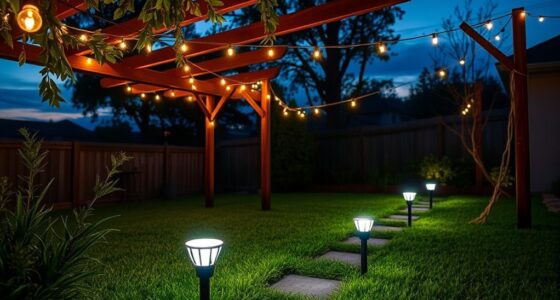To keep bugs at bay outdoors, adopt proactive, integrated strategies like removing standing water, using physical barriers, and employing targeted, eco-friendly treatments. Relying solely on sprays or home remedies won’t give lasting results and can cause resistance. Regularly inspect for breeding sites and combine methods such as traps, screens, and natural repellents for best protection. Keep your outdoor space pest-free by staying consistent—you’ll discover even more effective solutions as you continue to explore.
Key Takeaways
- Implement an integrated pest management plan combining physical barriers, environmental modifications, and targeted treatments.
- Eliminate standing water and breeding sites to prevent mosquito proliferation effectively.
- Use physical traps, screens, and netting to block pest entry without relying solely on chemicals.
- Apply pesticides correctly and sparingly, prioritizing environmentally friendly options to avoid resistance and environmental harm.
- Regularly inspect and maintain outdoor spaces, adapting strategies to ensure long-term pest prevention.

Are you taking the right steps to keep outdoor bugs at bay? If not, you might be missing key strategies that can markedly reduce pests and protect your outdoor space. Bed bugs, for example, can live outdoors and easily sneak into your home without notice. That’s why outdoor control isn’t just about reacting to infestations but implementing proactive, all-encompassing prevention. Relying on a single treatment method won’t cut it in the long run. Instead, you need a combination of approaches that work together to keep pests at bay.
Effective outdoor pest prevention requires proactive, combined strategies—not just reactive treatments.
Many people make the mistake of misapplying pesticides. Using the wrong chemicals, incorrect concentrations, or improper application methods can lead to poor results. Not only does this waste your money, but it also risks health hazards for your family and pets. Overuse or broad application of pesticides can also harm beneficial insects and pollute the environment through runoff. That’s why understanding proper pesticide use and opting for targeted, environmentally friendly options is essential. Incorrect application can lead to resistance, rendering treatments ineffective over time. Proper training and adherence to label instructions are vital for effective and safe pest control.
When it comes to mosquitoes, resistance is a common challenge. Repeatedly spraying the same insecticides, especially pyrethroids, can lead to the development of “super mosquitoes” that are resistant and harder to control. To combat this, removing standing water is one of the simplest yet most effective steps. Check your yard for flowerpots, gutters, and plastic containers where water collects and eliminate those breeding sites. Using eco-friendly larvicides like BTI (Bacillus thuringiensis israelensis) mosquito dunks targets larvae without harming other wildlife, offering long-term control.
Physical pest control methods also play a critical role. Traps that capture rodents and insects without chemicals provide a safe, effective alternative. Electric zappers attract and eliminate flying pests immediately, while physical barriers like screens and netting keep bugs out of your outdoor living areas. Combining these physical methods increases overall effectiveness and reduces reliance on chemicals, protecting beneficial insects and the environment. Additionally, regular maintenance of these barriers ensures their longevity and effectiveness.
Successful outdoor pest control often involves multiple strategies working together. Managing breeding grounds by removing standing water and vegetation can drastically cut mosquito populations. Short-term solutions like citronella candles, foggers, and fans can temporarily reduce pests during outdoor gatherings. Long-term investments, such as CO2-releasing traps, continuously lower mosquito numbers without harmful chemicals. An integrated approach offers the best protection against pests and mosquito-borne illnesses, ensuring you enjoy your outdoor space comfortably. Consistent monitoring and adaptation of your methods are key to maintaining pest-free outdoor areas.
Avoid relying solely on bug-repellent plants or unproven home remedies. These methods are ineffective when used alone and won’t address the root of the problem. Pests tend to develop resistance to common insecticides, making chemical controls unsustainable over time. Overusing DIY methods can lead to pest resurgence or environmental damage. Instead, focus on a balanced, integrated pest management plan that combines physical, biological, and minimal chemical controls for the most effective, safe outdoor pest control. Neglecting to regularly inspect and treat outdoor spaces can allow pests to establish and re-infest your area. Regular inspections help catch problems early before they become major infestations.
Frequently Asked Questions
Are Natural Remedies Effective Against Outdoor Bugs?
Natural remedies can be effective against outdoor bugs, but their success varies. You might find lemon eucalyptus oil and citronella oil work well for repelling mosquitoes, especially when applied correctly. Growing plants like lavender and catnip can also help deter bugs naturally. Keep in mind, natural repellents often need frequent reapplication and may not last as long as chemical options, but they’re safer and eco-friendly.
How Often Should Outdoor Bug Treatments Be Applied?
Did you know regular outdoor bug treatments can reduce pest activity by up to 80%? You should typically spray quarterly to maintain a pest barrier, but in high activity areas, bi-monthly treatments work better. After heavy rain, reapply to restore protection. During peak mosquito season, monthly treatments are recommended. Adjust the frequency based on pest levels, weather, and specific pests like ticks or ants for the best outdoor protection.
Can Pets Safely Be Around Outdoor Bug Control Products?
You can keep pets safe around outdoor bug control products by following proper precautions. Always wait until sprays or treatments are completely dry before allowing your pets back outside. Remove pet food, water bowls, and bedding from treated areas, and wash your hands afterward. Use pet-safe products as directed, and avoid applying pesticides during windy weather to prevent accidental exposure. Monitoring product labels for specific safety instructions is essential to protect your pets.
What DIY Methods Are Best for Large Outdoor Areas?
Think of your yard as a fortress, where your DIY methods serve as loyal guards. To protect large outdoor areas, create natural barriers with sprays of garlic, chili, or neem oil around edges and entry points. Combine this with planting pest-repellent herbs like marigolds and basil. Keep standing water away, and introduce beneficial insects. Regularly reapply sprays and maintain your landscape, turning your space into a resilient, bug-free sanctuary.
Do Certain Plants Repel Specific Bugs Effectively?
You’re wondering if certain plants repel specific bugs effectively. Yes, some plants work better against particular pests. For example, lemongrass and citronella are effective against mosquitoes, especially *Aedes aegypti*. African basil (*Ocimum gratissimum*) also shows promise. Keep in mind, though, that the effectiveness varies by insect species and plant concentration. Using these plants strategically can help reduce bug presence naturally, but they might not eliminate all pests.
Conclusion
Now that you’ve got these outdoor bug control tricks up your sleeve, you’re armed with a shield against pesky invaders. Think of your yard as a fortress, with citronella candles and screened zones as your loyal guards. With a little effort, bugs will find your outdoor oasis a tough nut to crack, letting you enjoy every sunset and starlit evening bug-free. Keep these strategies close, and your outdoor paradise will remain a bug-free sanctuary.









